A whole lot of nothing. That’s what we expected to see on our journey across eastern Montana—flat and drear, sagebrush and maybe the occasional bovine chewing its cud with a bored expression. After all, we’d heard predictions to that effect nearly every time we told anyone we were riding the Central Montana Highway from border to border. “There’s a whole lot of nothin’ out there,” twanged the farmhand in the Winnett Bar—where the rancher laughed when he heard where we were headed.
“North Dakota?” he scoffed with a blue-eyed glint. “That ain’t the end of the world, but you can see it from there.”
Before you listen to them, though, remember this: These guys see this country every day, like looking at their faces in the mirror. They live on the edge of Montana’s Big Open. Their county, although nearly as big as the state of Delaware, counted just 292 households in the last census. Heck, more cattle than people call this place home.
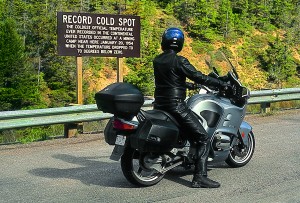
We, on the other hand, were delighted with what we found. OK, the eastern highway itself offers about as much excitement as a Saturday night in Winnett (where, if you believe the bartender, drying paint really is a spectator event). But the scenery—puckered, rippled, dotted with eerie land formations, rising in colorful badlands—always changes, always surprises. And the towns? True to Montana form, each has its own story, its own character, its own dreams—all of them populated with friendly, helpful people. Even in Winnett, once the bartender deigned to acknowledge our hungry faces, we found ourselves regaled with stories about the town and a treasure chest full of pirate jokes.
Of course, we traveled on our BMW R1100RT in springtime, that all-too-brief season of green and wet and cool in a climate where extremes are the norm—bitter cold and blowing snow one half of the year, blast-furnace heat and drought the other half.
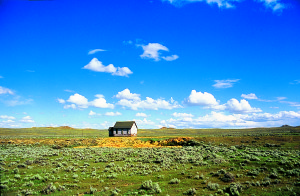
That’s in the eastern part of the state. We began our trip in the west, at the border with the Idaho panhandle, amid pine forests and along the Clark Fork River flowing as broad and blue as a lake and glinting so clear you can make eye contact with the trout if you stop long enough. Fishing is the main attraction here, and the charming little towns such as Trout Creek, just southeast of the Noxon Reservoir, and Thompson Falls show signs of a thriving summer economy, evidenced by their quaint tackle shops, ice-creameries and hanging plants blooming in florid optimism.
The highway winds in generous scoops through this section, flowing like a playmate of the Clark Fork with mountains rising shadowlike behind you. Gas stations and C-stores dot the route all the way to Plains at 77 miles, then disappear all the way to Highway 93, another 39 miles. Up for a detour? The town of Hot Springs, 19 miles north of Plains off Highway 28, features the Symes Hotel, a popular and inexpensive hot-springs resort and restaurant.
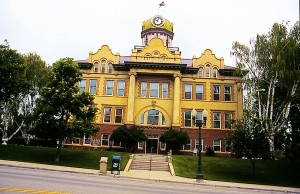
Continuing along Highway 200, you’ll pass through the fittingly named Paradise as well as Perma and Dixon, places rather than full-fledged towns. Bars and cafés offer food, but if it’s the weekend you might want to save your appetite for the Wild Plum Café in Dixon, a funky eatery and art gallery with a mercantile attached.
At Dixon, the highway offers an added treat: the sight of the mighty Mission Mountains thrusting sharply upward and, in the spring, snow-pocked over the river valley. These beauties pop in and out of view as the highway merges with Highway 93 to head south for about 30 miles. Up until now, you’ve enjoyed fairly sparse traffic, but it picks up on this busy two-laner with occasional passing lanes. Heads up, for it’s a dangerous highway, too: “Pray for me,” the bumper sticker reads, “I drive 93.” But the Missions keep you company for the first part of the drive and cafés offer buffalo burgers and huckleberry shakes, the quintessential western Montana meal.
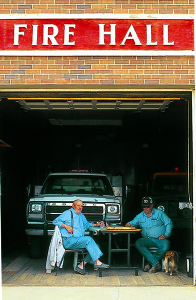
Now for the least enjoyable segment of the ride, the merging of Highway 200 with Interstate 90. But, hey, it’s only about nine miles to Missoula, and the speed limit is 75 mph, with a 10-mph grace (which applies to all state highways, by the way). That means you can ride 85 on the interstate with impunity. Yee haw!
The city of Missoula is definitely worth a stop. In fact, we’d recommend spending the night here. It’s got the river, the mountains, the western Montana (temperate) weather, a lively downtown and lots of good places to eat. Our favorites: Scotty’s Table and, next door, the Hob Nob Café, serving lunch and dinner on Higgins Avenue south of the bridge (the Hob Nob has great breakfasts, too).
From here, follow the interstate a few more miles to the Bonner exit, and swoop along gentle sweepers through alternating forests and meadows alongside the flirtatious Blackfoot River, made famous by Norman McLean’s book (and Robert Redford’s movie) A River Runs Through It. We spend the night at the Lincoln Hotel in Lincoln, a little burg in which the biggest excitement in recent years was the arrest of Unabomber Ted Kaczynski, living in a cabin nearby. The restaurant in the old log hotel offers a gourmet menu.
A few miles east of Lincoln the highway winds up to Rogers Pass, a record cold spot, where the temperature plunged to 70 below in 1954. And that was without wind chill! Descend on twisty curves and say good-bye to them, and to the forest, for the highway unfurls in a straight line now, a bold ribbon cutting across the plains past the beautiful old stone barn built in the early 1880s by J.C. Adams at the intersection with Highway 89 (the barn sits on private property, but you can see it from the highway) and into the city of Great Falls, where Pat Spon-heim has been performing in the O’Haire Motor Inn’s Sip-n-Dip tiki bar for 42 years.
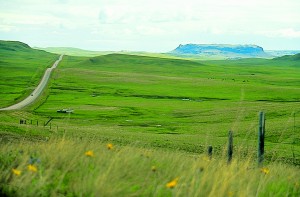
Surrounded by white Christmas lights, plastic foliage and bamboo, Sponheim plays electronic keyboard and warbles lounge standards (Sinatra) as well as updated favorites (a happy, up-tempo “Ring of Fire”). As if Sponheim weren’t enough to set the Sip-n-Dip apart, the lounge also features an aquarium-style window through which swimmers in the motel’s outdoor pool can be seen. GQ included the bar in its list of 10 “Worth Flying For” in 2003, and actress Daryl Hannah reportedly made a splash here several years ago by donning the lounge’s resident mermaid costume and performing water tricks for bar patrons.
The O’Haire, by the way, is itself a great place to spend the night, its art-deco rooms not only comfortable but also reasonably priced. The motel is within walking distance of downtown, where the Cool Beans Coffee Bar offers espresso, sandwiches and free Internet access in a colorful setting of art, overstuffed furniture and a mahogany backbar made in Indonesia. Co-owner Dave Rismens shakes his head when he hears where we’re headed and, true to human nature, can’t resist regaling us with Eastern Montana Horror Stories, such as running out of gas in Baker on a Saturday night and, as a last resort, illegally siphoning fuel from a city tractor to avoid being stuck there until Monday morning.
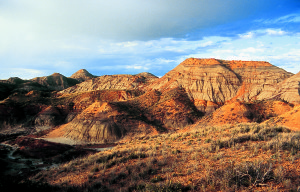
“You’re gonna find a whole lot of nothing out there,” Rismens warns.
Maybe, but not yet. Mountain ranges line the drive to Lewistown, majestic even if a bit distant: the Highwoods, the Snowies, the Little Belts, the Moccasins, the Judiths, zigzagging across the horizon as we ride, dominating the north, then the south.
And then there’s Lewistown. Although only 5,900 people live in this quaint town, its economy seems to thrive; the Yogo Inn, besides sitting on the geographic center of the state, hosts numerous conventions including the Montana Cowboy Poetry Gathering, held annually in August. The Yogo also offers tickets for excursions aboard the Charlie Russell Chew-Choo, a 31⁄2-hour dinner-train ride that includes a staged shoot-’em-up robbery. What the Yogo doesn’t offer: a break on prices. For that, head to the Calvert Hotel, a dorm in the early 1900s for rural high-schoolers but now an old-fashioned hotel with antiques in every room. There’s no pool or spa but, heck, there’s an old metal-chute fire escape that looks like fun and an antique telephone booth with a working dial phone.
After an off-highway trek to see the 1,500-year-old pictographs and petroglyphs—along with some 1800s graffiti—at Macie Lundlin’s ranch near Grass Range, we hit the open highway steeled for the most tedious ride of our lives.
Wrong.
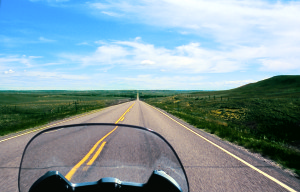
Sure, Highway 200 cuts a straight line across the state and the land is so open the occasional ranch house seems an aberration, if not outright effrontery. But as we hurtled through the Big Open, we found plenty to keep our eyes engaged: land folded in on itself like so many plump laps; little cones of rock, badlands and cliffs striated in colors to rival anything found in the Southwest. Halfway across, in Circle, make sure to stop for a “black and white” at Chapin’s, an old-fashioned soda fountain dating back to 1940. Then, be ready to make a choice, for just east of here, Highway 200 splits
in two. The high road, 200 proper, leads to Sidney, the shopping mecca for the entire northeast quadrant of the state—thousands of square miles—but, alas, a strip-development town if ever there was one. From here, it’s just a short hop to Fairview and the North Dakota border.
Or follow 200 south to Glendive, a charming little railroad town on the Yellowstone River with the breathtaking badlands of Makoshika State Park on its southern border. Unfortunately, it has a downtown as broken and full of gaps as a hothead’s mouth after a barfight. An oil boom brought happy times to Glendive decades ago, but a bust in the early 1980s sent half the population elsewhere.
That’s the story of almost every town we visited along Highway 200—east of Lewistown, at least. It’s a story of hardship, yes, but also of courage, perseverance, ingenuity and, despite the most isolating conditions, of community. We found beauty in the land, the sky and the people along the Central Montana Highway—and, far away from our Missoula oasis of lattes and liberalism—we found something else: A renewed pride in calling Montana home, and in calling ourselves Montanans.
(This article Highway 200: Riding the Heart and Soul of Montana was published in the August 2005 issue of Rider magazine.)







